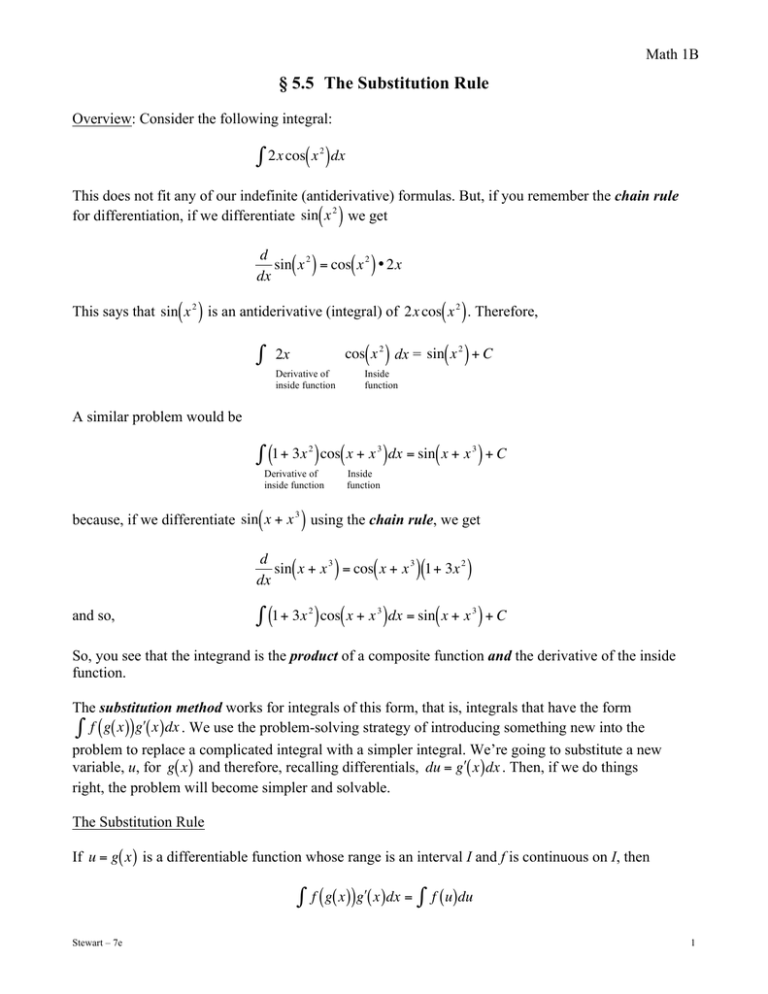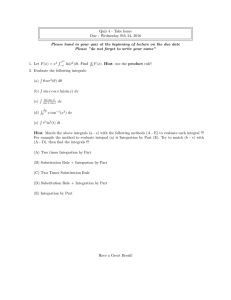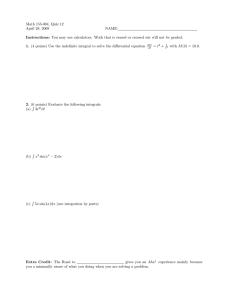( ) ∫
advertisement

Math 1B § 5.5 The Substitution Rule Overview: Consider the following integral: ∫ 2x cos( x )dx 2 This does not fit any of our indefinite (antiderivative) formulas. But, if you remember the chain rule for differentiation, if we differentiate sin( x 2 ) we get € € d sin( x 2 ) = cos( x 2 ) • 2x dx This says that sin( x 2 ) is an antiderivative (integral) of 2x cos( x 2 ) . Therefore, € ∫ 2x Derivative of inside function € A similar problem would be € € cos( x 2 ) dx = sin( x 2 ) + C € Inside function € ∫ (1+ 3x ) cos( x + x )dx = sin( x + x ) + C 2 Derivative of inside function 3 3 Inside function sin( x + x 3 ) using the chain rule, we get because, if we differentiate € d sin( x + x 3 ) = cos( x + x 3 )(1+ 3x 2 ) dx € ∫ (1+ 3x ) cos( x + x )dx = sin( x + x ) + C and so, 2 3 3 € So, you see that the integrand is the product of a composite function and the derivative of the inside function. € The substitution method works for integrals of this form, that is, integrals that have the form ∫ f (g( x ))g"( x )dx . We use the problem-solving strategy of introducing something new into the problem to replace a complicated integral with a simpler integral. We’re going to substitute a new variable, u, for g( x ) and therefore, recalling differentials, du = g"( x ) dx . Then, if we do things right, the problem will become simpler and solvable. € The Substitution Rule € € If u = g( x ) is a differentiable function whose range is an interval I and f is continuous on I, then ∫ f (g( x ))g"( x )dx = ∫ f (u)du € Stewart – 7e 1 € Example: Evaluate the indefinite integral by making the given substitution. a) ∫ 2x sin( x )dx ; u = x 2 b) 2 4 5 ∫ x (2 + x ) 3 € € dx ; u = 2 + x 4 € Note: To figure out what to use for the substitution u, look for some function in the integrand whose differential also occurs (except for a constant factor). If that doesn’t work, try choosing u to be some complicated part of the integrand. Remember, you’re looking for the inner function in a composite function. If your first choice doesn’t work, try something else. Example: Evaluate the indefinite integrals. a) b) ∫ sec2θ tan2θdθ ∫ x (x 2 + 1) 2 dx € € c) ∫ (ln x ) x 3 d) dx ∫ tan−1 x dx 1+ x 2 € € Stewart – 7e 2 e) ∫e ex dx x +1 f) ∫ sin t sec (cos t )dt h) ∫ 2 € € g) ∫ sin y dy y x dx x +1 € € i) ∫ tan xdx € Stewart – 7e 3 The Substitution Rule for Definite Integrals If g" is continuous on [a, b] and f is continuous on the range of u = g( x ) , then b g( b) a g a ∫ f (g( x ))g"( x )dx = ∫ ( ) f (u)du € € Note: This means that you can change the limits of integration from x-values to u-values. € Example: Evaluate the following definite integrals. a) ∫ 7 0 b) 4 + 3x dx ∫ π 0 8 sin 2 2x cos2xdx € € c) ∫ 1 0 e x dx € Stewart – 7e 4 Integrals of Symmetric Functions Suppose f is continuous on ⎡⎣ −a,a ⎤⎦ . If f is even, that is f ( −x ) = f ( x ) , a then ∫ −a If f is odd, that is f ( −x ) = − f ( x ) , a a f ( x ) dx = 2 ∫ f ( x ) dx then ∫ f ( x ) dx = 0 −a 0 Example: Evaluate the following definite integrals. 2 a) ∫ (x 6 ) + 1 dx −2 Stewart – 7e π 2 b) ∫ − π2 x 2 sin x dx 1+ x 6 5 Table of Indefinite Integrals ∫ c f (x ) d x ∫k =c ∫ f (x ) d x dx = kx + C n ∫ x dx = ∫ tan x dx x n +1 +C n +1 (n ≠ − 1) ∫x −1 = ln sec x + C 1 dx = ∫x x ∫ a dx = ∫ sin x dx ∫ cos x dx 2 = − cos x + C x dx = tan x + C ∫ sec x tan x dx ∫x 2 = sec x + C 1 d x = t a n− 1 x + C +1 ∫ sinh x dx = cosh x + C ∫ csc 2 dx = ln x + C ax +C lna x x ∫ e dx = e + C ∫ sec Stewart – 7e ∫ !# f (x ) + g (x )"$ d x = ∫ f (x ) d x + ∫ g (x ) d x = sin x + C x dx = − cot x + C ∫ csc x cot x dx ∫ 1 1− x 2 = − csc x + C d x = s i n− 1 x + C ∫ cosh x dx = sinh x + C 6





